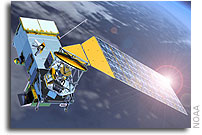GAO: Polar Satellites: Agencies Need to Address Potential Gaps in Weather and Climate Data Coverage

David A. Powner, director, information technology management issues, before the Subcommittees on Investigations and Oversight and Energy and Environment, House Science, Space, and Technology Committee. GAO-11-945T, September 23.
In May 2010, GAO reported on the transition from NPOESS to two separate programs, and recommended that both NOAA and DOD expedite decisions on the cost, schedule, and capabilities of their respective programs. Since that time, both agencies have made progress on their programs, but neither has finalized its plans or fully implemented the recommendations.
NOAA is currently focusing on the October 2011 launch of the NPOESS Preparatory Project satellite–a demonstration satellite that the agency now plans to use operationally in order to minimize potential gaps in coverage. In addition, NOAA has transferred contracts for satellite sensors from the NPOESS program to the JPSS program. However, NOAA officials stated that the agency slowed down the development of the first JPSS satellite due to budget constraints, causing a delay in the launch date. As a result, NOAA is facing a potential gap in satellite data continuity. Such a delay could significantly impact the nation’s ability to obtain advanced warning of extreme weather events such as hurricanes.
Meanwhile, DOD began planning for its satellite program. Department officials reported that DWSS is to consist of two satellites with three sensors: an imager, microwave imager/sounder, and a space environment sensor. The first satellite is to be launched no earlier than 2018. The department has not, however, finalized the cost, schedule, and functionality of the program. It expects to do so in early 2012. Until both NOAA and DOD develop and finalize credible plans for their respective programs, it will not be clear what the programs will deliver, when, and at what cost. In its prior report, GAO also recommended that NOAA and DOD establish plans to mitigate key risks in transitioning from NPOESS to the successor programs, including ensuring effective oversight of JPSS program management, and addressing cost and schedule implications from contract and program changes. Both agencies have taken steps to mitigate these risks, but more remains to be done.
For example, NOAA could not provide firm time frames for completing its management control plan or addressing residual contracting issues. Moving forward, it will be important for the agencies to continue efforts to mitigate these risks in order to ensure the success of their respective programs. GAO is not making new recommendations in this statement.








